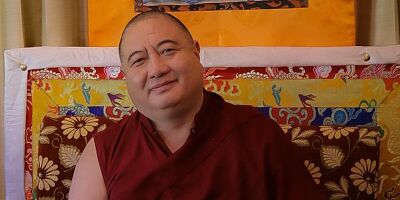Shechen Rabjam Rinpoche
| PersonType | Category:Abbots Category:Tibetan Buddhist Teachers Category:Tulkus |
|---|---|
| MainNamePhon | Shechen Rabjam Rinpoche |
| MainNameTib | འཇིགས་མེད་ཆོས་ཀྱི་སེངྒེ་ |
| MainNameWylie | 'jigs med chos kyi seng+ge |
| SortName | Shechen Rabjam Rinpoche |
| bio | Shechen Rabjam Rinpoche, born in 1967, is the grandson and spiritual heir of Dilgo Khyentse Rinpoche. Since his grandfather’s passing in 1991, Rabjam Rinpoche has taken the responsibility of transmitting Dilgo Khyentse Rinpoche’s teachings, and is bringing his vision for the preservation of Tibetan Buddhist teaching and culture to fruition.
Rabjam Rinpoche is the seventh in the line of the Rabjam succession. The second Rabjam Rinpoche founded Shechen Monastery in Kham, eastern Tibet. (Source Accessed Feb. 10, 2022)
|
| YearBirth | 1966 |
| associatedwebsite | Official Shechen.org |
| affiliation | Shechen Monastery |
| religiousaffiliation | Nyingma |
| EmanationOf | Zhechen Rabjam, 6th |
| StudentOf | Dilgo Khyentse Tashi Paljor |
| BDRC | https://www.tbrc.org/#!rid=P624 |
| IsInGyatsa | No |
| BnwShortPersonBio | Shechen Rabjam Rinpoche, born in 1967, is the grandson and spiritual heir of Dilgo Khyentse Rinpoche. Since his grandfather’s passing in 1991, Rabjam Rinpoche has taken the responsibility of transmitting Dilgo Khyentse Rinpoche’s teachings, and is bringing his vision for the preservation of Tibetan Buddhist teaching and culture to fruition.
Rabjam Rinpoche is the seventh in the line of the Rabjam succession. The second Rabjam Rinpoche founded Shechen Monastery in Kham, eastern Tibet. Themonastery became one of the six main Nyingma Monasteries in Tibet but was destroyed in the mid-twentieth century. At the age of three, Rabjam Rinpoche began taking teachings from his revered grandfather and today holds this unbroken lineage. He was raised by Dilgo Khyentse Rinpoche and attended almost every teaching, drupchen (9-day ceremony), and empowerment that he gave during twenty-five years. He traveled throughout the world with Khyentse Rinpoche and first visited the West in 1976. In the early 1980’s Dilgo Khyentse Rinpoche built Shechen Tennyi Dargyeling Monastery in Nepal and established Rabjam Rinpoche as its abbot. Today, there are 450 monks studying and practicing there under his guidance. Rabjam Rinpoche has created an administration and organization within the monk community that is a model of education, joyful discipline, and humanitarian activity. Rabjam Rinpoche established the Shechen Philosophical College and the Shechen Retreat Center in Nepal. In response to the needs of women wanting to practice and study in the lineage of Dilgo Khyentse Rinpoche, he rebuilt and improved the facilities of the Sisinang Nunnery in Bhutan where 180 nuns of all ages study and practice. In accordance with the wish of Dilgo Khyentse Rinpoche, he built a small Nyingma monastery and study center in Bodhgaya, India. Rinpoche supervised the education and upbringing of Khyentse Yangsi Rinpoche, the young incarnation of Dilgo Khyentse Rinpoche. He also is the president of the Shechen School, an impressive monastic school that includes secular education. (Source: Shechen Monastery) |
| Other wikis |
If the page does not yet exist on the remote wiki, you can paste the tag |


